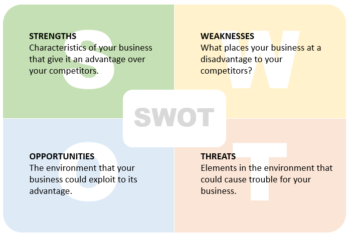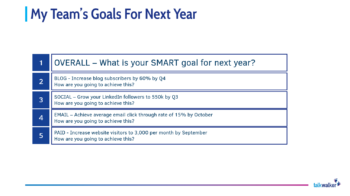
If you want a marketing plan strategy that’s going to work, you have to be brutally honest. You need discipline, time, and focus; recognize your strengths and weaknesses, your competitive advantage, and your target market.
Let’s go!
This article offers up spoilers from 5 Steps to Planning a Winning Marketing Strategy a guide offering practical and actionable steps, templates, checklists, and real-life examples. There are brainstorming best practices – bun fights hold no value, finding customer insights that have real value, how to write your vision and mission statements, SWOT analysis, and finding SMART goals. Check out the guide if you want to dig deeper. It’s all tried, tested, and proven stuff.

SWOT analysis
Selling your Marketing Plan to the Boss
A marketing strategy isn’t just something to chat about over lunch. It’s not justification for spending hours on Facebook during working hours. When it comes to selling the plan to your boss, be prepared to define your objectives and strategy, demonstrate how you’re planning to attract new customers, boost sales, strengthen brand value, and increase and then prove ROI. Be ready to answer questions like these:
- Is it necessary? Prove you’ve done your research, that you understand your target market, competitors, and budget.
- How much will it cost? Hard figures, no fluff.
- Who are we targeting? Existing customer base or targeting a new segment, explain how you will target your audience.
- How are you going to measure results? KPIs to measure marketing effectiveness, tracking metrics like email subscribers, engagement rate, open rates, click-through, time spent on website, etc.
Step 1: Reporting on Last Year’s Marketing Plan
Understand your current position, before you move forward. Identify what’s worked and what hasn’t, check whether your customer base has shifted, perform SWOT analysis, and find out what the competition has been up to.
 Talkwalker’s social listening tool – demographic filter
Talkwalker’s social listening tool – demographic filter
Looking at your previous marketing plan, find your objectives. Did you run an email campaign? Was your website revamped? Did you initiate a new SEO strategy? Track all areas of your online marketing efforts and then show the results.
Quantitative and qualitative analytics will identify what worked and what didn’t; looking at hard data and then putting that data into context.
Step 2: Generating New Ideas
Brainstorming is problem solving, generating new ideas, encouraging cross-functional communication, identifying your competitive advantage, and for promoting innovation.
There has to be collaboration in your company, the sharing of information. Each team has a unique perspective and the feedback you collect will give a comprehensive picture of your customers.
Step 3: Strategy
Develop your marketing plan to achieve maximum profit and sustainability. Bring the six Ps into play: product, price, people, promotion, place, and positioning.
Using your SWOT analysis, you can build a strategy that plays on your strengths, and minimizes your weaknesses.
Identify your assets, such as your website, blog, social media channels, team – don’t forget your team, none of this is possible without your team. Once done, you can draw up an action plan that should specify:
- What will be done
- Time
- Who’s responsible for what
- Cost
- Measurable projected outcome
Step 4: Setting Goals
Yes, you’ve heaps of brilliant ideas, goals you’re desperate to achieve. But, are they SMART?
- Specific– real numbers with real deadlines: who, what, where, why?
- Measurable– how will you track and evaluate your achievements?
- Achievable– work toward a goal that’s challenging, but possible.
- Relevant– do you have the resources to make it happen?
- Timed– when will you achieve your goal?
 SMART goals
SMART goals
You need to establish how many goals and what type. Be really sure that they’re realistic, or your setting yourself up for failure.
Step 5: Planning Next Year
Now it’s time to pull it all together, ensuring you’ve allocated sufficient resources to achieve your goals. Have you got enough people in your team? Do you need to outsource or recruit? Don’t under estimate the cost – the size of your budget depends on how much you have to invest and how quickly you want to see results.
Now you’re ready to sit down with your boss and present your marketing plan. Go for it!
Creating a marketing plan is not about guesswork or flights of fancy, it takes serious consideration. You have to measure what you’ve done in the past, find what worked and what didn’t. And only then can you plan for the new year.
I’ve given you a taster of what’s in the guide – 5 Steps to Planning a Winning Marketing Strategy. There’s a lot more information, plus templates, checklists, and examples. It’ll save you so much time in the long run.
Photo credit

